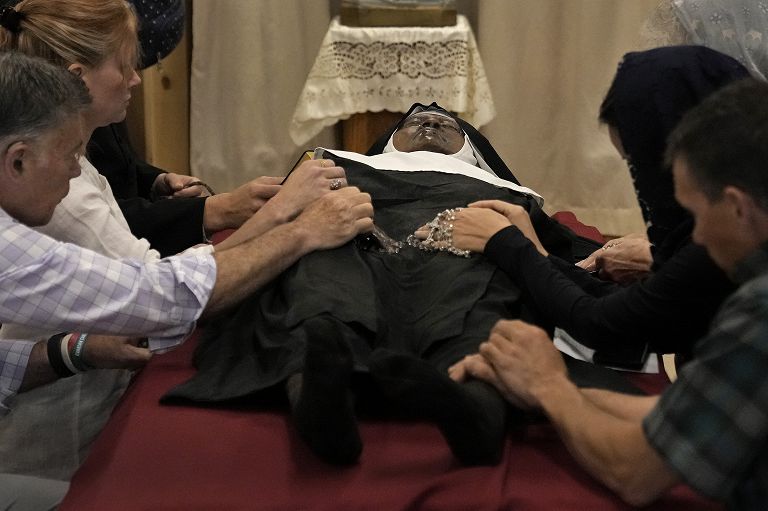In Missouri, in the heart of that deep, Catholic and Trumpian America, there is a cry for a miracle. The body of a nun, who died in 2019 and was exhumed by chance after four years, shows almost no signs of decomposition. This is Wilhelmina Lancaster, who died at the age of 95, foundress of the convent of the Benedictine Sisters of Mary, Queen of the Apostles, and buried in Gower, 1,500 inhabitants 60 km north of Kansas City (about an hour's drive).
And right here, in the seat of the religious convent, crowds of faithful, pilgrims, curious and devout, rushed en masse in recent days to see with their own eyes the sign of that prodigious event, giving life to real pilgrimages. Those who arrive approach the body of the nun (now placed in a glass case), kneel, shell rosaries, pray. There were also visits from Canada and Mexico.
Exhumation and surprise
The nuns initially tried to keep the information secret. But it was useless: last weekend, on the occasion of the day dedicated to the memory of the dead in the struggle in defense of the US flag, 15 thousand crossed the threshold of the small chapel of the Benedictines of Mary. The nun had founded the order in 1995, at the age of 70.
According to the sisters, the wooden coffin in which the mortal remains of Wilhelmina Lancaster had been placed was opened last May 18, to move them to the chapel of the monastery dedicated to St. Joseph, after the end of the work of realization of the work. Only a few bones were expected to be found, considering the regular processes of decomposition of a lifeless body. Instead, an intact body appeared at their sight. Moreover, confirming the absolute rarity of the phenomenon, the sisters explained that the corpse had not been embalmed immediately after the death of Sister Willelmina.
Even the mother abbess of the convent, Cecilia Snell, intervened on the matter, telling that she had looked herself through a small crack, created on the lid of the coffin in the act of opening it: seeing the nun's foot with the sock still on, Sister Cecilia was initially surprised. The mother abbess made light with a torch, scrutinizing the rest: "I couldn't believe it" she limited herself to commenting on a local TV.
AP Photo
The remains of Sister Wilhelmina Lancaster
The case is now also being investigated by the Diocese of Kansas City-St. Joseph. The hypothesis of a case of incorruptibility is being evaluated, which according to Catholic tradition indicates a divine intervention that stops or slows down decomposition, as a sign of holiness. At the moment, there has been no official stance. Bishop Vann Johnston, a member of the diocese where jurisdiction over the convent falls, said a "thorough investigation" was needed to answer "important questions" raised by the state of the body, but it was not known if or when such an analysis would take place. In any case, the prelate adds, "the state of Sister Wilhelmina's remains has understandably aroused wide interest and raised questions. At the same time, it is important to protect the integrity of Sister Wilhelmina's mortal remains," the same source added. The body of the nun had initially been exposed, without protection, and the faithful could touch it with their hands. Now, since last Monday, it is in a transparent case.
A biography "as a saint"And also on the biography of the nun were immediately overlapped stories, anecdotes and documented episodes, which did nothing but increase the sense of mystery and prodigy that hovers around her figure: second of five children, born to Catholic parents in St. Louis, Wilhelmina had mystical experiences already as a child. At the age of 9, on the occasion of his first communion, he said he had seen Jesus and found him "beautiful".
The story of the nun's life, written by the religious of the community, says that on that occasion Jesus asked her to become a nun. She then took her vows at the age of 13, becoming a devotee of the Tridentine Mass and fighting ever since in defense of the traditional rite.
To stiffen the veil of her dress, Wilhelmina had used bleach in such quantity that it was hard and impenetrable, a detail that was decisive when she was hit in the neck with a dagger by a student, while teaching in Baltimore. The blade did not sink into the flesh and even then there was talk of a miracle.
The enthusiasm of the faithful"It's a modern-day miracle. And above all, with all that is happening in the world, something like this brings hope. We had to experience magic and miracle," Tonya and William Kattner, originally from Excelsior Springs, Missouri, told Catholic News Agency (CNA), among the tens of thousands of pilgrims who came to Gower. "I strongly believe in the Catholic faith. I believe in miracles and I've never seen anything like it before," said Kate Jalloh of Kansas City. Some scientists, asked about the case, argued that the "delay" in the decomposition process is neither exceptional nor rare.

